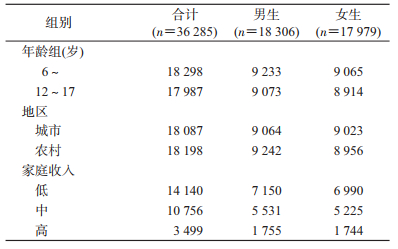文章信息
- 房红芸, 翟屹, 赵丽云, 于冬梅, 张倩, 琚腊红, 于文涛, 赵文华.
- Fang Hongyun, Zhai Yi, Zhao Liyun, Yu Dongmei, Zhang Qian, Ju Lahong, Yu Wentao, Zhao Wenhua.
- 中国6~17岁儿童青少年超重肥胖流行特征
- Epidemiological characteristics of overweight and obesity in Chinese children and adolescents aged 6-17 years
- 中华流行病学杂志, 2018, 39(6): 724-727
- Chinese Journal of Epidemiology, 2018, 39(6): 724-727
- http://dx.doi.org/10.3760/cma.j.issn.0254-6450.2018.06.006
-
文章历史
收稿日期: 2017-09-28
2. 102206 北京, 中国疾病预防控制中心慢性病防治与社区卫生处
2. Division of Non-communicable Diseases Control and Community Health, Chinese Center for Disease Control and Prevention, Beijing 102206, China
在过去的几十年里,儿童超重肥胖的患病率不仅在发达国家增加,而且在发展中国家也迅速增加[1]。超重肥胖是成年人慢性疾病的危险因素,儿童超重肥胖患病率的上升可能导致慢性疾病在整个生命周期内的发病率增加[2]。本研究利用“2010—2012年中国居民营养与健康状况监测”数据,分析我国6~17岁儿童青少年超重肥胖流行特征,为人群营养改善、超重肥胖防治策略制定及慢性病防控提供科学依据。
资料与方法1.资料来源:利用“2010—2012年中国居民营养与健康状况监测”中6~17岁儿童青少年调查资料。该调查采用多阶段分层整群随机抽样的方法,将县级行政单位分为4类,即大城市、中小城市、普通农村和贫困农村。第一阶段从4类地区共抽取150个县级单位作为监测点;第二阶段每个监测点等距抽取6个村(居)委会;第三阶段每个村(居)委会采用简单随机抽样方法抽取75户,≥6岁家庭成员参加调查[3]。为了保证儿童青少年样本量的要求,在样本地区的中小学校适当补充了儿童青少年人群,其中每个监测点6~17岁儿童青少年不少于240人,每个年龄组人数不低于20人,纳入分析的有效分析样本量为36 285人。本研究通过中国CDC营养与健康所伦理审查委员会批准(批准文号:2013-018),所有调查对象由家长签署知情同意书。
2.调查方法:①问卷调查:采用自行设计并经专家论证和调查表收集调查对象的基本信息,由培训合格的调查员通过面对面调查的方式进行问卷调查。②体检:采用集中体检的方式,身高、体重测量均由经过统一培训并考核合格的调查员按照标准的测量步骤进行。身高测量使用指定身高测量仪(南通悦健体侧器材有限公司SG-210型),精确度为0.1 cm。体重测量使用指定体重秤(无锡衡器厂有限公司RGT-14-RT杠杆式体重秤),精确度为0.1 kg。均测量一次。
3.判定标准:①超重肥胖的判定:6岁儿童采用WHO 2007年推荐的分年龄性别BMI超重肥胖判定标准进行判定[4],7~17岁儿童青少年采用《中国学龄儿童青少年超重和肥胖预防与控制指南》中分年龄、性别的BMI超重肥胖判定标准判定超重肥胖[5]。②家庭经济收入水平划分:根据家庭年人均收入(万元)水平分为高(≥2.5)、中(1~)、低(<1)3组[6]。
4.统计学分析:采用SAS 9.4软件进行统计学分析,对数据进行复杂抽样加权调整[7],权重包括抽样权重和事后加权权重,事后加权以国家统计局提供的2009年全国人口数据为标准。将年龄、性别、城乡、经济水平等作为分层因素,采用surveyfreq过程计算率及其95%CI值,差异性检验采用复杂抽样数据的多重logistic回归分析方法。
结果1.一般特征:共有6~17岁儿童青少年有效数据36 285人,其中男生18 306人(城市9 064人,农村9 242人),女生17 979人(城市9 023人,农村8 956人)。见表 1。
2.儿童青少年超重肥胖状况:我国6~17岁儿童青少年超重率、肥胖率分别为9.6%和6.4%,其中男生超重率、肥胖率分别为10.9%和7.8%,女生分别为8.2%和4.8%。城市6~17岁儿童青少年超重率和肥胖率分别为11.0%和7.7%,其中城市男生超重率和肥胖率分别为12.8%和9.7%,女生分别为9.0%和5.5%;农村6~17岁儿童青少年超重率和肥胖率分别为8.4%和5.2%,其中农村男生超重率和肥胖率分别为9.3%和6.2%,女生分别为7.4%和4.1%。见表 2,3。
季成叶等[7]、梅建[8]及马军和吴双胜[9]将1985—2005年我国7~22岁学生超重肥胖发展大致归纳为3个阶段:基本不存在肥胖问题-超重率大幅增加-超重肥胖全面增长期。2002年中国居民营养与健康调查结果表明[10],我国7~17岁儿童青少年超重率、肥胖率分别为4.5%和2.1%,城市儿童青少年超重率和肥胖率分别为农村儿童青少年的2.7倍和3.1倍。本研究结果显示,2012年,我国6~17岁儿童青少年超重率和肥胖率分别为9.6%和6.4%,城市儿童青少年超重率和肥胖率分别为农村儿童青少年的1.3倍和1.5倍,我国儿童青少年超重肥胖发生率依然为城市高于农村,男生高于女生,农村儿童青少年超重肥胖的增长速度高于城市儿童青少年。
2002—2012年10年间我国儿童青少年超重肥胖率增长迅速,主要体现的特征:男生超重肥胖的增长速度高于女生;城市男生仍为超重肥胖的重点防控人群;农村男生超重率、肥胖率均已赶超城市女生,农村男生超重肥胖状况不容忽视。2002年,我国城市男生和女生、农村男生和女生分别有15.6%和10.0%、5.0%和4.1%的超重肥胖[10]。2010—2012年监测结果表明,我国城市男生和女生、农村男生和女生分别有22.5%和14.5%、15.5%和11.5%的超重肥胖。10年间,我国城市男生和女生、农村男生和女生超重肥胖率分别上升6.9和4.5、10.5和7.4个百分点,超重肥胖增长速度为男生高于女生,农村高于城市。城市儿童青少年超重及肥胖率最高,过去我们一直把儿童青少年超重肥胖的防控重点放在城市,农村儿童青少年超重肥胖状况亦不容忽视。WHO在2010年全球非传染性疾病现状报告中指出[11],中等收入以上群体儿童的超重及肥胖率最高,而较低收入群体儿童的超重及肥胖率上升最快。尽管低收入国家的人群超重肥胖率最低,但也在随时间推移而迅速上升。在低收入国家,家庭收入的增加与婴儿和儿童的超重率升高正相关。而在高收入国家,如英国和美国,社会经济地位较低者反而肥胖率较高。本研究结果表明,我国儿童青少年超重率、肥胖率随家庭经济收入水平的提高而升高,其中家庭经济收入水平高的男生中,超过1/4的男生罹患超重或者肥胖。与2002年相同,我国儿童青少年超重率、肥胖率依然表现为城市高于农村,经济发达地区高于不发达地区,男生高于女生,家庭经济收入水平高的高于家庭经济水平低的[10]。
2014年11月,第二届世界营养大会在罗马召开,大会通过了《营养问题罗马宣言》和《行动框架》,其中《营养问题罗马宣言》明确指出营养不良的形式,分别是发育迟缓、消瘦、微量元素缺乏、超重肥胖,其中儿童所受影响严重[12]。随着经济和社会的快速转型,中国正在面临严峻的儿童青少年肥胖问题,目前我国青少年肥胖问题呈现出肥胖率历年持续增长、城乡存在差异等特征。我国政府正积极应对儿童青少年肥胖问题,实施了一系列肥胖预防和控制的公共卫生项目,近年来对支持性环境建设也已给予重视,包括健康的饮食环境和积极的身体活动环境,这对推动和促进行为的长期改变十分重要。
利益冲突: 无
| [1] | Lobstein T, Jackson-Leach R, Moodie ML, et al. Child and adolescent obesity:part of a bigger picture[J]. Lancet, 2015, 385(9986): 2510–2520. DOI:10.1016/S0140-6736(14)61746-3 |
| [2] | World Health Organization. Diet, nutrition and the prevention of chronic diseases: report of a joint WHO/FAO expert consultation[R]. Geneva, Switzerland: WHO, 2002. http://ci.nii.ac.jp/ncid/BA6263076X?l=en |
| [3] |
赵丽云, 马冠生, 朴建华, 等. 2010-2012中国居民营养与健康状况监测总体方案[J]. 中华预防医学杂志, 2016, 50(3): 204–207.
Zhao LY, Ma GS, Piao JH, et al. Scheme of the 2010-2012 Chinese nutrition and health surveillance[J]. Chin J Prev Med, 2016, 50(3): 204–207. DOI:10.3760/cma.j.issn.0253-9624.2016.03.002 |
| [4] | World Health Organization.WHO child growth standards:length/height-for-age, weight-for-age, weight-for-length, weight-for-height and body mass index-for-age[M]. Geneva: WHO, 2006: 312. |
| [5] |
陈春明. 中国学龄儿童少年超重和肥胖预防与控制指南[M]. 北京: 人民卫生出版社, 2008.
Chen CM.Guidelines for prevention and control of overweight and obesity among school-age children and adolescents in China[M]. Beijing: People's Medical Publishing House, 2008. |
| [6] |
常继乐, 王宇. 中国居民营养与健康状况监测:2010-2013年综合报告[M]. 北京: 北京大学医学出版社, 2016.
Chang JL, Wang Y.Comprehensive report of china national nutrition and health surveillance 2010-2013[M]. Beijing: Peking University Medical Press, 2016. |
| [7] |
季成叶, 孙军玲, 陈天娇. 中国学龄儿童青少年1985-2000年超重、肥胖流行趋势动态分析[J]. 中华流行病学杂志, 2004, 25(2): 103–108.
Ji CY, Sun JL, Chen TJ. Dynamic analysis on the prevalence of obesity and overweight school-age children and adolescents in recent 15 years in China[J]. Chin J Epidemiol, 2004, 25(2): 103–108. DOI:10.3760/j.issn:0254-6450.2004.02.004 |
| [8] |
梅建. 青少年儿童1985-2005年体质健康发展状况和对策研究[J]. 中国青年研究, 2007(11): 22–28.
Mei J. On constitution and health development of youth and children from 1985 to 2005 and the countermeasures thereof[J]. Chin Youth Stud, 2007(11): 22–28. DOI:10.3969/j.issn.1002-9931.2007.11.005 |
| [9] |
马军, 吴双胜. 中国学龄儿童青少年超重肥胖流行趋势分析[J]. 中国学校卫生, 2009, 30(3): 195–197, 200.
Ma J, Wu SS. Trend analysis of the prevalence of obesity and overweight among school-age children and adolescents in China[J]. Chin J Sch Health, 2009, 30(3): 195–197, 200. |
| [10] |
王陇德. 中国居民营养与健康状况调查报告之一:2002综合报告[M]. 北京: 人民卫生出版社, 2005.
Wang LD.Comprehensive report, Chinese nutrition and health survey 2002[M]. Beijing: People's Medical Publishing House, 2005. |
| [11] | World Health Organization. Global status report on noncommunicable diseases 2010: description of the global burden of NCDs, their risk factors and determinants[R]. Geneva: WHO, 2011. |
| [12] | FAO, WHO. The Rome declaration on nutrition: the second international conference on nutrition (ICN2)[R]. Rome: FAO, 2014. |
 2018, Vol. 39
2018, Vol. 39





